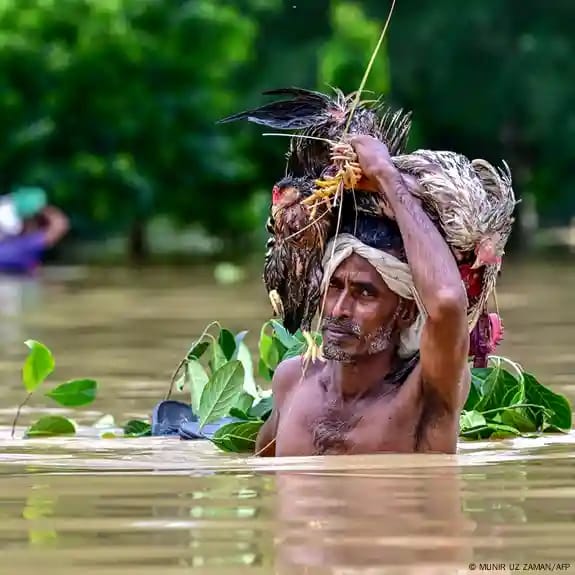Floods in Bangladesh: A Devastating Impact on Millions
In a tragic turn of events, heavy rains have caused devastating floods in Bangladesh and northeast India, resulting in at least 36 deaths and displacing millions. The catastrophic floods in Bangladesh have submerged entire communities, triggering mass evacuations and forcing residents to seek refuge on rooftops.
Bangladesh Faces Unprecedented Flooding: Millions Impacted
Bangladesh has borne the brunt of this disaster, with nearly 4.5 million people affected by the floods in Bangladesh. According to the Disaster Management Ministry, torrential rains have caused rivers to overflow, submerging hundreds of homes and leaving residents trapped. The floods in Bangladesh have resulted in at least 13 deaths, with 200,000 people evacuated from the hardest-hit areas.
Md Kamrul Hasan, a senior official with Bangladesh’s Ministry of Disaster Management and Relief, stated that rescue operations are underway to provide shelter for the displaced. Government buildings and high schools have been converted into temporary shelters, housing over 25,000 people.
Tripura State in India Severely Affected by Flooding
The situation is critical in India’s northeastern state of Tripura, which shares a border with Bangladesh. Over 64,000 people have been displaced, seeking shelter in relief camps as their homes were submerged by floodwaters. The floods in Bangladesh and Tripura have claimed 23 lives in the region. Flooding and landslides have complicated rescue efforts, underscoring the need for better infrastructure and disaster preparedness.
Climate Change: A Major Factor in Extreme Weather Events
Flooding during the monsoon season is common in South Asia, but experts warn that the ongoing climate crisis is exacerbating these extreme weather events, making them more frequent and severe. The floods in Bangladesh and northeast India highlight how climate change is intensifying natural disasters, leading to higher death tolls and widespread destruction. Addressing climate change has become more critical than ever.
For more information on climate change’s impact on floods, visit UN Climate Change or explore IPCC Reports on Climate Impact.
Rescue Efforts in Bangladesh’s Feni District
In Feni district, Bangladesh, one of the worst-affected areas, rescue operations are in full swing. Army and navy personnel, along with local volunteers, are evacuating residents using boats. Makeshift shelters have been set up in government buildings and schools. Despite these efforts, the situation in Feni remains dire, as water levels remain alarmingly high.
A resident, Kazi Piash, shared the harrowing experience of seeking refuge on his rooftop: “We’ve constructed a makeshift tent on the roof with tarpaulin, but there are about 40 of us on the roofs of two one-story homes.” His plea for urgent help emphasizes the critical need for continued rescue efforts.
Flooding Fuels Tensions Between Bangladesh and India
The catastrophic floods in Bangladesh have sparked tensions with India. Some residents in Bangladesh accuse India of causing the disaster by releasing water from the Dumbur Dam without proper warning, leading to protests in Bangladesh. Nazma Akther, a resident of Cumilla city, voiced her concerns: “This flood came from India because they opened the dam.”
Indian officials, however, deny these allegations, stating that the floods were due to the heaviest rains of the year, not the opening of the dam. India’s Ministry of External Affairs clarified that the release of water was an automatic response to high reservoir levels, not a deliberate action. Tripura’s Power Minister also stated that no deliberate action was taken.
For a deeper understanding of transboundary water issues, visit International Rivers or read South Asian Water Conflicts.
Ongoing Crisis: More Rain Expected
As the crisis continues, more rain is expected in the coming days, which could worsen the floods in Bangladesh. Weather forecasts predict an additional 50 mm to 150 mm (2 to 6 inches) of rain, adding to the ongoing flooding. Damaged infrastructure and weak phone networks have complicated rescue and relief efforts, making it difficult to assess the full extent of the damage.
Conclusion: Addressing the Impact of Climate Change and Building Resilience
The deadly floods in Bangladesh and northeast India are a tragic reminder of the devastating impact of extreme weather events in regions vulnerable to climate change. This disaster underscores the need for improved disaster preparedness, better infrastructure, and international cooperation to address the root causes of these events.
For more insights on disaster preparedness, explore UNDRR Resources or check Global Climate Action.
The affected communities are grappling with the aftermath, and both countries must work together to prevent future tragedies. The lessons learned from this disaster should inform future policies, ensuring that vulnerable populations are better protected from the impacts of climate change.
For more news around the globe, click NewsAIH.








